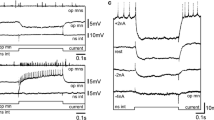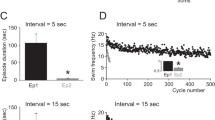Abstract
Stimulation of the spinal cord of the electric fishGymnotus carapo, evoked an abrupt increase in the discharge rate of the electric organ. At the maximum of this response, the rate increased an average of 26 ± 11.8%. The duration of the response was 4.9 ± 2.12 s; its latency was 10.4 ± 1.1 ms. Activation of the Mauthner axon played a decisive role in this phenomenon as indicated by the following: (1) recordings from the axon cap of the Mauthner cell demonstrated that the response was evoked if the Mauthner axon was antidromically activated and (2) a response that was similar to that produced by spinal cord stimulation, was elicited by intracellular stimulation of either Mauthner cell. Stimulation of the eighth nerve could also increase the discharge rate of the electric organ. The effect was greater if a Mauthner cell action potential was elicited. The findings described in the present report, indicate the existence of a functional connection between the Mauthner cell and the electromotor system inGymnotus carapo. This connection may function to enhance the electrolocative sampling of the environment during Mauthner-cell mediated behaviors. This is a novel function for the Mauthner cell.
Similar content being viewed by others
Abbreviations
- EHP :
-
extrinsic hyperpolarizing potential
- EOD :
-
electric organ discharge
- M-AIR :
-
Mauthner initiated abrupt increase in rate
- M-cell :
-
Mauthner cell
- M-axon :
-
Mauthner axon
- PM :
-
pacemaker nucleus
- PM-cell :
-
pacemaker cell
- PPn :
-
prepacemaker nucleus
- SPPn :
-
sublemniscal prepacemaker nucleus
References
Baker CL (1980) Jamming avoidance behavior in gymnotoid electric fish with pulse-type discharges: sensory encoding for a temporal pattern discrimination. J Comp Physiol 136: 165–181
Barrio LC, Caputi A, Crispino L, Buño W (1991) Electric organ discharge frequency modulation evoked by water vibration inGymnotus carapo. Comp Biochem Physiol A 100: 555–562
Black-Cleworth P (1970) The role of electric discharges in the non-reproductive social behavior ofGymnotus carapo (Gymnotidae, Pisces). Anim Behav Monogr 3: 1–77
Bennett MVL, Pappas GD, Gimenez M, & Nakajima Y (1967) Physiology and ultrastructure of electrotonic junctions. IV. Medullary electromotor nuclei in gymnotiform fish. J Neurophysiol 30: 236–300
Borde M, Pereda AE, Morales FR (1991). Electrophysiological characteristics of the Mauthner cell of the weakly electric fishGymnotus carapo. Brain Res 567-: 145–148
Canfield JG, Rose GJ (1993a) Activation of Mauthner neurons during prey capture. J Comp Physiol A 172: 611–618
Canfield JG, Rose GJ (1993b) Electrosensory modulation of escape response. J Comp Physiol A 173: 463–474
Eaton RC, Bombardieri RA, Meyer DL (1977) The Mauthner initiated startle response in teleost fish. J Exp Biol 66: 65–81
Eaton RC, Di Domenico R, Nissanov J (1988) Flexible body dynamics of the goldfish C-start: implications for reticulospinal command mechanisms. J Neurosci 8: 2758–2768
Eaton RC, Di Domenico R, Nissanov J (1991) Role of the Mauthner cell in sensorimotor integration by the brain stem escape network. Brain Behav Evol 37: 272–285
Ellis DB, Szabo T (1980) Identification of different cell types in the command (pacemaker) nucleus of several gymnotiform species by retograde transport of horseradish peroxidase. Neuroscience 5: 1917–1924
Faber DS, Korn H (1978) Electrophysiology of the Mauthner cell: basic properties, synaptic mechanisms, and associated networks. In: Faber DS, Korn H (eds) Neurobiology of the Mauthner Cell. Raven Press, New York, pp 47–131
Faber DS, Fetcho JR, Korn H (1989) Neuronal networks underlying the escape response in goldfish. Ann NY Acad Sci 563: 11–33
Furshpan EJ, & Furukawa T (1962) The intra- and extracellular responses of the several regions of the Mauthner cell of the goldfish. J Neurophysiol 25: 732–771
Hagedorn M (1986) The ecology, courtship, and mating of gymnotiform electric fish. In Bullock TH, Heiligenberg W (eds) Electroreception. Wiley, New York, pp 497–525
Heiligenberg W (1986) Jamming avoidance responses: model systems for neuroethology. In Bullock TH, Heiligenberg W (eds)Electroreception. Wiley, New York, pp 613–649
Heiligenberg W (1991)Neural nets in electric fish. Computational Neuroscience Series, MIT Press
Heiligenberg W, Finger T, Matsubara J, Carr C (1981). Input to the medullary pacemaker nucleus in the weakly electric fish,Eigenmannia (Sternopygidae, Gymnotiformes). Brain Res 211: 418–423
Kawasaki M, Heiligenberg W (1988) Individual prepacemaker neurons can modulate the pacemaker cycle of the gymnotiform electric fish,Eigenmannia. J Comp Physiol A 162: 13–21
Kawasaki M,. Heiligenberg W (1989) Distinct mechanisms of modulation in a neuronaloscillator generate different social signals in the electric fishHypopomus. J Comp Physiol A 165: 731–741
Kawasaki M, Heiligenberg W (1990) Different classes of glutamate receptors and GABA mediate distinct modulations of a neuronal oscillator, the medullary pacemaker of a gymnotiform electric fish. J Neurosci 10: 3896–3904
Keller CH, Kawasaki M, Heiligenberg W (1991) The control of pacemaker modulations for social communication in the weakly electric fishSternopygus. J Comp Physiol A 169: 441–450
Kramer B, Tautz J, Markl H (1981) The EOD sound response of weakly electric fish. J Comp Physiol 143: 435–441
Lee RK, & Eaton RC (1991). Identifiable reticulospinal neurons of the adult zebrafish,Brachydanio rerio. J Comp Neurol 304: 34–52
Lissmann HW (1958) On the function and evolution of electric organs in fish. J Exp Biol 35: 156–191
Szabo T (1957) Un noyeau particulier dans la formation réticulée bulbaire de quatre poissons élèctriques appartenant à la famille desGymnotidae. CR Acad Sci (B) (Paris) 244: 1957–1959
Trujillo-Cenóz O, Ecagüe JA, Macadar O (1984) Innervation pattern and electric organ discharge waveform inGymnotus carapo (Teleostei; Gymnotiformes). J Neurobiol 15 (4): 273–281
Westby GW (1974) Assessment of the signal; value of certain discharge patterns in the electric fishGymnotus carapo, by means of playback. J Comp Physiol 92: 327–341
Author information
Authors and Affiliations
Rights and permissions
About this article
Cite this article
Falconi, A., Borde, M., Hernández-Cruz, A. et al. Mauthner cell-initiated abrupt increase of the electric organ discharge in the weakly electric fishGymnotus carapo . J Comp Physiol A 176, 679–689 (1995). https://doi.org/10.1007/BF01021588
Accepted:
Issue Date:
DOI: https://doi.org/10.1007/BF01021588




